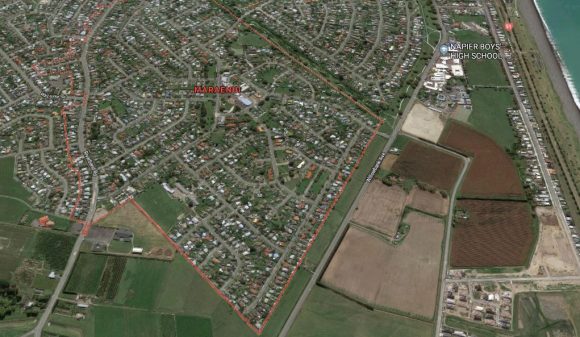The Developer Chronicles: Master-planned Projects
In this series, I describe master-planned projects. The discussion focuses on the difference between a one-off project and a multi-stage, multi-year planned development. I explore the factors that great development teams grapple with every day. I hope you find it of value.
AND via LinkedIN you can also contribute to this opensource education by commenting with your own experiences, strategies, tactics and ideas. That’s where we can really embrace group network effects for continuous improvement in development management. Connect Here.
…
The DC: Master Planned Projects #1 Roads
When you purchase a single project site in an established area, more than likely you don’t have to think too hard about the location of public roads. That’s because they already exist and there is little you can influence their design and configuration. Sure, you might be able to tweak a corner, add some trees, move around driveways, but that will be about it.
Of course, existing roads come their own problems. If it’s a tight site you might need to consider road width to fit a crane or delivery truck in. Do you have to shut down the road to connect to water and utilities? Is a bus stop in the way of your proposed garage entrance? Are you allowed a driveway from that particular road? Are you obliged to have retail along the frontage? And the list of planning and practical requirements goes on.
But today we are not talking private roads or internal ‘joint-owned’ accessways that you need to get cars parked and in and out of your development. We are talking about the big new roads – the public roads that will be owned by the local authority.
Let’s assume your development involves people that arrive and leave using vehicles with wheels (just in case it’s 2030 and you have found this on the interweb, and everyone now flys around in some sort of hydrogen powered drone). When you embark on a master-planned project, for a period of time, and potentially the entire time, roads are going to occupy both the right and left sides of your brain. The right side, because as boring as it sounds roads require creativity. The left hand side, because you are going to bombarded with a whole heap of technical analysis where logic should prevail.
What on earth’s tarmac can be creative about roads you ask? Traffic engineers will give you a whole heap of answers to that one. To the rest of us only a few of those will sound marginally creative. But from a developer’s point of view, how you deal with roads can maketh a project. And when I say maketh, I mean maketh money — or loseth.
When commencing a master-planned development from scratch, staring at a prairie of nothingness, one of the first things you must decide is what sort of roads you need and where they are going to go. Sounds easy right?
Hmmm…
Occasionally the location and size of the roads within your site will be prescribed through planning regulations. In other cases, you may only be dictated to as far as where the roads must start and finished, based on the intersections, to the existing roading network that border your site. In that case, where the road routes within, is up to you. Even so, that direction is typically only for the larger roads, the main highways, arterials, avenues and collectors.
In addition to those significant roads, you have a whole roading network to design. You must allow for the movement of vehicles from the existing network to the homes, shops, warehouses, offices (or whatever your master-planned estate includes). And allow for the traffic generated on every journey.
Your local authority/council will have a plethora of rules to help your architect complete a roading design. More than likely you will also need a traffic engineer to model the numbers, to determine what size roads and intersections you need. That’s where the left side of the soft stuff inside the cranium is tapped. Well at least should be, since it’s just all numbers and logic, right? Unfortunately, no. You would think an engineer’s trip generation model (you know: how many drivers are going to be backed up at the lights at Monday 7.45am trying to access the freeway) would be purely analytical and not subject to opinion. But, at least where I have worked, that is not the case. Traffic engineers and their pac-man like digital scenarios square off against one another all the time.
Usually, it goes something like this.
Developer: My development on this piece of road will only generate 385 trips per hour.
Other side: We think it will generate 500 trips per hour.
Developer: The data shows I only need a 20-yard-wide road and a small roundabout.
Other side: Our projections say you need to put in traffic lights, another lane and by the way, you will also have to upgrade the existing intersection 2 miles down the street. Oh yes and you also need another road over here.
And then the argy bargy continues, quite often ending in court. All manner of arguments, with creative number crunching supporting them. And the local community gets their say – mainly those NOMS (Not On My Street) who are opposed to a single additional car in their neighborhood and every commercial enterprise who wants to stop the competition coming to town. So, it can get political. Who knows who has influenced who and how in the background. Eventually, someone banging a mahogany table in an ivory tower decides whose data and argument is best.
Why then can’t the two parties, the developer and the local authority see eye to eye?
Well roads are expensive to build. The bigger they are, the more expensive they are to build. Intersections are especially costly, so are retaining walls holding them up, let alone bridges or tunnels. If you have to upgrade existing public road infrastructure, then the costs go stratospheric. The bigger and more elaborate the ‘traffic device’ the more money it takes away from the developer’s margin. Or put another way, the higher the price the developer has to charge buyers for their new homes/factories/business premises. Naturally, developers want to keep costs down. And that usually means building the fewest least expensive roads (and all the civil paraphernalia in tow) as possible.
But, not always.
More expensive roads can add value. A wide tree lined avenue with a generous plant packed median, can add prestige to a residential subdivision. A solid dual lane expressway, linking to the local freeway may be your new industrial estate’s main drawcard. Having enough lanes so morning commuters can easily access their offices without a traffic jam at the business park entrance could help increase the lease-up velocity.
However, no developer enjoys paying for road infrastructure that has no direct financial benefit to their sales and marketing effort. The river of roads, both existing downstream and future upstream, can impact on what the developer is asked, or forced by the authorities, to pay.
When you are seeking approval for a master-planned project that eventually will see hundreds or thousands of people live, work or visit there, then there will likely be downstream impacts on the local network. i.e. you are creating additional traffic that must drive on an existing road, through an existing community, and navigate existing intersections to get to your development. At certain triggers – the number of cars each peak hour or similar — the local roading network authority will need to upgrade those existing roads. And unless lucky enough to be the beneficiary of a budget already in place, the developer will be asked to pay.
Similarly, your development might be on the outskirts of town and you are forced to provide a through-route to allow for upstream development by others in years to come. That may be a much wider, more expensive road than is required for your development alone. Again, unless the beneficiary of an established budget you will be asked to pay.
Doesn’t sound fair does it? When developing your master-planned project, just because you are first off the rank, you might have to pay for big ticket public infrastructure that benefits others – existing residents and adjacent developers!
There might be ways around paying for every road and intersection though. On one hand it depends on the sophistication and political proclivity towards public infrastructure investment of the authority presiding over your location. On the other hand, it depends on your ability to creatively hustle deals together with landowners and road network operators.
Targeted rates, where everyone who benefits pays additional rates/tax on their land for a period of time is flavour of the month in New Zealand. Public road infrastructure funding by governments is often more forthcoming to those building homes during a housing crisis (not always though!). If the road is big enough to deserve a toll, then public-private-partnerships might be an option. Or simply try lobbying officials and politicians for your project’s share of the next budget.
Doing a deal with neighbouring developers (whose projects will benefit from the public roads when built) sounds simple in theory. Why wouldn’t they want to unlock their own development? But in practice, unless the local authority has a mechanism to compel everyone to reach agreement, it often comes down to a first-come, first served basis. And by served, I mean with a big fat invoice! If other developers are not as eager as you to get their project underway, then they might be able to wait you out. In that case you might be left with no option but to pay everything for these roads.
And guess what? Resolving all this takes a painful amount of time and money. When you are dealing with significant public roads and the public are involved along with officials and politicians it is not going to be simply a case of here is a design, please approve. It can be a long drawn out process, even if you don’t end up in court. And local politicians have elections, different government projects get priority and authority funding changes. All of sudden progress on your grand master plan with beautifully rendered perspectives of meticulously landscaped roads meandering through a tranquil coastal subdivision, all approved ‘in principle’ by the officials of the day, can come to a screeching halt as there is no longer public funding to help pay for it. Or they change their mind. Now your road is the prime candidate for a bus station – please adjust your plans. Or we don’t want the cycleway there anymore – please adjust your plans. Or our structural criteria rules have changed, that road is too close to the stream for that retaining wall – please change your plans. Or the community is not allowing a right turn into that street – please adjust the plan. Frustratingly this is all time and money down the curbside drain for the developer – albeit heaps of fees for consultants redoing all their plans!
Eventually, you get the main public roads resolved and figure out who is paying for what*. Now you can finally design your internal road network. That’s all the smaller roads that will link up with the bigger ones to create the blocks of land where you can construct some buildings. Where I am, we call those blocks of land ‘super-lots’: a parcel of land bounded by public roads (and occasionally a topographical feature like the coast, a stream or a park). Often this parcel of land can then be subdivided further into smaller individual lots for sale.
* Developers can find themselves running the significant public road ‘negotiations’ and the complete road network design concurrently. This adds considerable risk and cost though, especially when changes are made, as now everything must be changed. The risks go up a magnitude when you are under time pressure to get roads resolved, so you can start the fun part – selling and building! Ideally, you sort all this big-picture roading infrastructure out before you purchase the land, or purchase it so cheap that you don’t care!
So, what do you need to think about when designing the entire road network?
– The optimum size of super-lots, primarily the width, depth and orientation. For example, if your project is a housing estate then you need to consider the size of the houses, the preferred lot sizes encompassing the houses and how they will be arranged within the super-lot. No point having an efficient roading network, which gives rise to inefficient lot depths and everyone’s back yard receives no sun.
– Private vs Public. What should be a public road and what could be made a private internal road? Public roads cost more money, primarily because they have more rules, like footpaths and driveway restrictions. Sometimes you can have less public roads but integrate more private access roads to separate ‘Super-lots’. This will mean a different ownership structure though, because if the roads are privately owned, the owners need a legal mechanism for control and maintenance.
– Flexibility. For a project that is expected to be built out over a decade or longer, it is highly likely what you think you are about to develop will evolve into something quite different in the future. Real estate markets change. Your large format logistics warehouses on 5000m2 sections of today might have to make way for smaller 200m2 commercial condos tomorrow. Six-bedroom McMansions with two kitchens for extended families on 500m2 plots, may prove no longer be affordable in your market. But terrace homes on 100m2 plots become all the rage. Zoning restrictions will usually limit the degree of flexibility you need, but not necessarily so. You might be forced to undertake a complete rezoning on part of your master-planned project because of market conditions half-way through your generational project schedule. So flexibility needs to be considered. Simply, the further out in time a piece of land is likely to be developed the more flexibility your road network should allow.
– Staging. What roads are you going to build first? Do you want to impress your potential market by putting in the public highway complete with mature cherry trees at the outset? Or can you defer big expense items to later in your build out? Do you need access to the public park you are building today, or can that wait? It might be as simple as starting from the entrance and working your way back into the site, stage by stage. Or because of complicating factors (like a whole heap of issues yet to be resolved) you might be forced to stage road construction in a piecemeal approach.
– What lies below? Rarely do you just build a road. Roads and the berms adjacent serve as a conduit for other infrastructure and utilities: water, stormwater, sewer, power, gas, and communications. Dealing with the authorities on those aspects might dictate where your roads can go. Capacity restraints in those other networks might also limit when you can build them.
– Topography. Designing a roading network that creates the most efficient and flexible super-lot layout is challenging when you have varying terrain to navigate. Hills have this problem of always getting in the way. There are usually rules on how steep your street and driveways can be. Even if you are allowed a steep street, it will make the house and individual lot construction more complicated as you have to build retaining walls as part of the house (expensive) or as part of the section (difficult to make look good if really high and in the backyard). Sure you can bulldoze it down to a nice flat template, but then you have our next point to consider.
– Civil construction cost. We discussed this before, but it’s always good to remind oneself to consider the total value proposition: how much does it cost versus how much value does it add? It costs money to dig up or retain hills, fill in valleys and move dirt around so you can build roads. Therefore any decision when designing your road must also take into account the cost to build. Shorter is cheaper. Thinner is cheaper. Fewer traffic lights are cheaper. Lower water crossings are cheaper. No point making the most efficient road network in the city, if you are forced to build the Golden Gate to get from one side to the other.
Finally, all of the above leads us to consider probably the most impactful decision when designing your road network. How do I minimize the loss of Net Developable Area (NDA) when I am designing these roads. Increasing NDA is like finding a diamond in the bitumen: it is land that you can sell!
We’ll talk more about Net Developable Area in the next edition of The Developer Chronicles: Master-planned Projects.
Cheers
Andrew Crosby
The DC: Master-planned Projects – All published editions.
#1 Roads
#2 Net Developable Area
#3 Feasibilities
#4 Stages
#5 Team Collaboration
#6 Architectural Design
#7 Scale Thinking
#8 Selling the Dream Location
P.S.
Now in this blurred world of social media versus professional media, my opinion versus my employer(s), salary versus side-hustle, middle of the business day versus 11pm on a Sunday evening, it can all get a bit confusing. So, here is my value proposition, and both complement and benefit each other.
- If you have a development site that you would like to sell some or all of, to develop yourselves, or to build houses then Universal Homes www.universal.co.nz might be able to help. We focus on delivering value-for-money homes in the ‘relatively affordable’ range, like the 1300 home westhills.co.nz or the 600 plus homes we have built at Hobsonville Point, or the thousands of others around Auckland over the last 60 years. Message me on LinkedIn at any time
linkedin.com/in/ajcrosby . - If you want to learn more about real estate / property development and a continuous improvement approach, with books and courses in development management to maximize profit and decrease risk then visit www.developmentprofit.com





